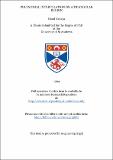Files in this item
Polynomial interpolation on a triangular region
Item metadata
| dc.contributor.advisor | Phillips, G. M. (George McArtney) | |
| dc.contributor.author | Yahaya, Daud | |
| dc.coverage.spatial | 201 p. | en_US |
| dc.date.accessioned | 2018-06-11T10:18:33Z | |
| dc.date.available | 2018-06-11T10:18:33Z | |
| dc.date.issued | 1994 | |
| dc.identifier.uri | https://hdl.handle.net/10023/13887 | |
| dc.description.abstract | It is well known that given f there is a unique polynomial of degree at most n which interpolates f on the standard triangle with uniform nodes (i, j), i, j ≥ 0, i + j ≤n. This leads us to the study of polynomial interpolation on a "triangular" domain with the nodes, S = {([i], [j]): i, j ≥ 0, i + j ≤n}, [k] = [k][sub]q = (1-qᵏ)/(1-q), q > 0, which includes the standard triangle as a special case. In Chapter 2 of this thesis we derive a forward difference formula (of degree at most n) in the x and y directions for the interpolating polynomial P[sub]n on S. We also construct a Lagrange form of an interpolating polynomial which uses hyperbolas (although its coefficients are of degree up to 2n) and discuss a Neville-Aitken algorithm. In Chapter 3 we derive the Newton formula for the interpolating polynomial P[sub]n on the set of distinct points {(xᵢ, y[sub]j): i, j ≥ 0, i + j ≤n}. In particular if xᵢ = [i][sub]p and y[sub]j = [j]q, we show that Newton's form of P[sub]n reduces to a forward difference formula. We show further that we can express the interpolating polynomial on S itself in a Lagrange form and although its coefficients Ln/ij are not as simple as those of the first Lagrange form, they all have degree n. Moreover, Ln/ij can all be expressed in terms of Lm/0,0, 0 ≤ m ≤ n. In Chapter 4 we show that P[sub]n has a limit when both p, q → 0. We then verify that the interpolation properties of the limit form depend on the appropriate partial derivatives of f(x, y). In Chapter 5 we study integration rules I[sub]n of interpolatory type on the triangle S[sub] = {(x, y): 0 ≤ x ≤y ≤ [n]). For 1 ≤ n ≤5, we calculate the weights wn/ij for I[sub]n in terms of the parameter q and study certain general properties which govern wn/ij on S[sub]n. Finally, Chapter 6 deals with the behaviour of the Lebesgue functions 𝜆[sub]n(x, y; q) and the corresponding Lebesgue constant. We prove a property concerning where 𝜆[sub]n takes the value 1 at points other than the interpolation nodes. We also analyse the discontinuity of the directional derivative of 𝜆[sub]n on S[sub]n. | en_US |
| dc.language.iso | en | en_US |
| dc.publisher | University of St Andrews | en |
| dc.subject.lcc | QA404.5Y2 | |
| dc.subject.lcsh | Orthogonal polynomials | en |
| dc.title | Polynomial interpolation on a triangular region | en_US |
| dc.type | Thesis | en_US |
| dc.contributor.sponsor | University of Malaya in Kuala Lumpur | en_US |
| dc.type.qualificationlevel | Doctoral | en_US |
| dc.type.qualificationname | PhD Doctor of Philosophy | en_US |
| dc.publisher.institution | The University of St Andrews | en_US |
This item appears in the following Collection(s)
Items in the St Andrews Research Repository are protected by copyright, with all rights reserved, unless otherwise indicated.

